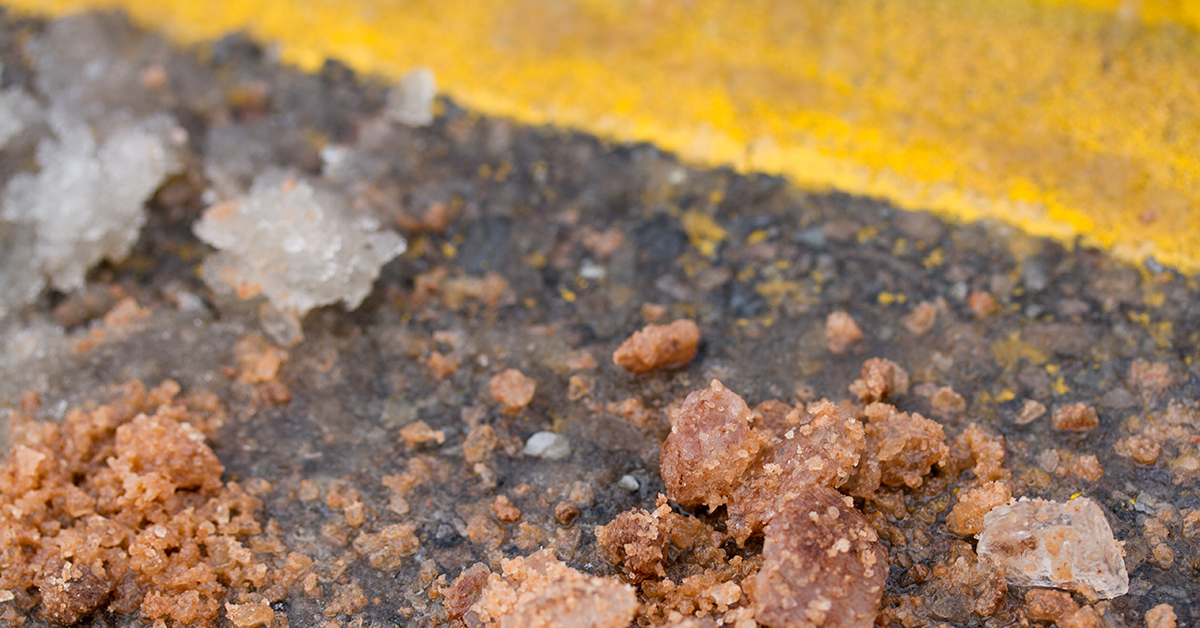Commercial building managers normally have four items of concern outside of the building itself: people, landscapes, sidewalks and parking areas. Taking these concerns into consideration, we will explore different alternatives available to deal with ice and snow while minimizing effects on plants, grass, concrete and asphalt. A sensible and effective deicing strategy is necessary in order to minimize negative effects and costs of deicing while keeping the various landscaping and transportation facilities safe.

Icy and snowy surfaces on steps, walkways and parking lots is extremely dangerous, leading to countless injuries each year. A building could be liable if someone slips and injures herself while on the property. So, removing snow and ice is a priority. Salt and most deicers are effective ice-melting agents because they lower the freezing point of water, turning ice back into water. Salts and deicers are cheap, effective, simple to use, and much easier and more efficient than attacking ice with brute physical force. Although safety comes first, building managers also may want to consider that deicer runoff to lawns and gardens can be a challenge for plants near roadways, sidewalks and other hardscape areas. Consider selecting salt-tolerant plants for areas near heavily salted roads.
Many of us have experience with spalling on concrete. Spalling is a result of water entering pores within the concrete and forcing the surface to peel, pop out or flake off. The freezing and thawing of concrete is one of the main causes of spalling, according to the Portland Cement Association. The other two main reasons are high water-tocement ratio and finishing concrete too early. Water is one of the few substances that expands as it freezes. When water lands on concrete and then freezes, it fills in the pores of the concrete and builds pressure, which weakens the concrete. To prevent this, concrete pavements must be properly constructed with sufficient entrained air to deal with water expanding as it freezes, as well as sufficient curing of the concrete.
Winter conditions also can produce damage to asphalt pavements due to a variety of factors, including the impact of freeze-thaw cycles and mechanical damage caused by snow removal equipment. The first step in preventing this is to have a well-constructed pavement to begin with. While the occasional nick from a snowplow may be unavoidable, proper structural design of the pavement layers will help them resist damage from freezing and thawing action, and good construction practices will keep unwanted material (water) from entering the pavement structure.
Choosing the Deicing Product
As a consumer of deicing products, you’ll have to balance your needs with any environmental concerns. Buyers should take claims that a product works to subarctic temps with a grain of salt, as those results rarely are duplicated in real world applications. Following are a few of the available options:
-
Sodium Chloride: Also known as rock salt, this basic compound is one of the cheapest ice melters on the market. It has the lowest price per pound, but it’s the hardest on the environment and not that effective at temps less than 15 degrees Fahrenheit. Many governmental users have increased usage of NaCl as 23.3 percent brine solution as a pretreatment/anti-icer.
-
Calcium Chloride: Experts agree that calcium chloride is one of the best ice melt for concrete surfaces. Being a hygroscopic compound, it absorbs moisture and thereafter starts dissolving. The dissolving process is exothermic and generates heat of up to 60 degrees Celsius. This heat quickly melts the ice and snow, thus turning it into water. Dissolved calcium chloride similarly works by breaking the bond that exists between concrete surfaces and ice. This compound is preferred because it is quick, less corrosive and poses fewer negative effects on landscaping and concrete.
-
Magnesium Chloride: Unlike many other ice melts, magnesium chloride can safely be used in heavily vegetated areas. This product works well and routinely is ranked by users as the best ice melt for concrete on the market. Magnesium chloride’s minimal working temperature is negative 13 F. This means that it’s almost as effective at lowering the working temperature as calcium chloride, and it is similarly as fast since it also is hygroscopic in nature.
-
Potassium Chloride: This is one of the best ice melt for concrete. Most people prefer it because it is less corrosive and has less negative effects on plant life. It works on concrete surfaces containing wire mesh or rebar. Nonetheless, potassium chloride is noticeably slower than other ice melts. Therefore, it might not be effective when a large amount of snow or ice needs to be cleared. Potassium chloride melts ice and snow in low temperatures down to negative 12 F. However, these deicers often cost more and have limited availability.
-
Calcium Magnesium Acetate: CMA is made up of acetic acid and dolomitic lime. The product is sometimes used to coat other ice melts. Unlike other ice melts, calcium magnesium acetate is a newer product that does not contain chloride. The chemicals work together to prevent snow particles from sticking together or to the surface, so it doesn’t form a brine. However, the product is effective only to 20 F. Instead, this means that its ability to prevent refreezing surpasses its ability to melt snow and ice. And, calcium magnesium acetate tends to leave behind a slush whenever it is used.
-
Ice Slicer: This product has the advantages of being put together by nature. Nature has imparted Ice Slicer products’ unique blend of natural chlorides outperforms liquid anti-icing chemicals and rock salt. It is a homogenous (not blended) product containing naturally occurring minerals, such as: complex chlorides (magnesium, calcium, sodium and potassium chloride), sulfur, iron, iodine, zinc, copper, manganese, phosphorous and 50-plus trace minerals. It contains natural corrosion inhibitors and environmental buffers crystallized within each granule, not simply sprayed on the surface. These products melt down ice and snow to 5 F, a full 10 degrees lower than regular road salt. Its “reddish” color accelerates ice melt by absorbing 50 percent more of the sun’s radiant energy than white deicing products. It also delivers enhanced traction, which eliminates the need for sand, thereby significantly reducing sediment loading in nearby wastewater plants and streams.
In summary, in order to buy the right product, you must select a product that best suits your property’s climatic conditions and average low temps. This means you will need less of it. The product you buy should also depend on addressing whatever is your main concern: people, landscape, sidewalks or parking areas. In many cases, it’s worth paying a little more upfront to offer better protection of the people and building assets.
If you would like to talk to a representative about optimizing your deicing or anti-icing program, feel free to contact EnviroTech at 1-800-369-3878.
Featured in the Property Management Quarterly, published April of 2018
For more information about EnviroTech Services’ please visit our website at www.envirotechservices.com or call 800-881-5848.

